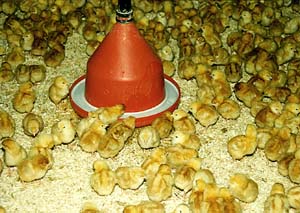
Coccidiosis is estimated to cost the UK’s poultry industry £40 million every year, with poor performing chickens the result of intestinal damage caused by a tiny, but ubiquitous, protozoa. In acute cases, it will even lead to mortality. But using Paracox vaccine will give protection against all seven species of coccidiosis known to affect chickens, Iain Brown, sales manager for Shering-Plough Animal Health, told producers attending a roadshow organised by the company.
"The main advantage in using Paracox for the pullet rearer is that outbreaks of the disease will be avoided in the rearing house and flocks will be up to target weight and more even by point-of-lay," Mr Brown told the audience gathered at Woodbury Park in Devon. "Egg producers will benefit from more productive birds and flocks will be fully protected from coccidiosis throughout the laying period."
In free range and organic birds, the opening of the popholes and allowing the birds outside could be a stressful period and was often accompanied by an outbreak of the disease, he said. Protection from coccidiosis with Paracox could also help avoid other gut problems, such as necrotic enteritis, an observation backed up by specialist poultry vet Richard Turner of the St David’s Practice in Exeter.
"This has caused very high mortality in some free range flocks but it doesn’t seem to be a problem where the birds have had Paracox," said Mr Turner. Another advantage to the egg industry of controlling coccidiosis with vaccination, said Mr Brown, was that it removed the risk of any contamination of eggs with anti-coccidial drugs, although he acknowledged that feed compounders had been successful in reducing the risk to a point where few problems arose.
But this added protection comes at a cost, and with the vaccine priced at around 10p a bird, the net cost to producers was in the region of 7 to 8 pence, taking into account the saving on anti-coccidiostats in the rearing ration.
"Yes, pullets can be reared successfully using anti-coccidial drugs," Mr Brown said, "and if the flock is subject to a challenge at around three weeks of age the rearer can treat the birds.
"The problem is," he went on, "the drugs have to be withdrawn several weeks before transfer to the laying house and that can leave the bird unprotected against a challenge if it hasn’t built up a natural immunity—and there will be no treatment option late in rear."
It was stressed that good administration technique was essential to ensure a good response to the vaccine, and most rearers chose through the drinking water as the best route, although the product is licensed for spraying onto the feed. The company is currently looking into the possibility of spraying the vaccine on to the chicks in the hatchery.
"Where we have had producers questioning the effectiveness of Paracox, nine times out of ten it can be traced back to problems with administration," said Mr Brown.
One rearer who has mastered the technique and is getting consistently good results is Stephen Blake from Launceston in Cornwall, who has been using Paracox for five years now.
"When we started to get customers asking for the vaccine we took the decision to switch completely to Paracox rather than rearing some with and some without," said Stephen, who rears around 100,000 birds each year. "This made life simpler for us and meant there was no risk from a mix up with a feed delivery going into the wrong bin, for once they’ve had the vaccine they cannot have any anti-coccidiostats," he told the Ranger. "It also meant that we could continue having feed from our local ABN mill which is just down the road at Lifton and is now run as a medication-free operation."
Stephen, with the help of his wife Dorothy, puts the Paracox through the water when the chicks are five days of age. He lifts the drinkers up for around two hours beforehand which, he says, leads to the young birds being sufficiently thirsty to quickly gather around the drinkers when they are lowered back down, ensuring good uptake of the vaccine.
"I measure the vaccine into the water using an automatic syringe, making sure it’s evenly distributed around the bowl, while Dorothy lowers them back down. We make a good team...and it keeps her fit!" he said.
But the real proof of their success is down to what happens once the birds are moved to the laying house and pullet customer John Widdowson is more than satisfied. "We moved over to Paracox several years ago because we were getting problems with coccidiosis and with no licensed treatment available, it was affecting performance," said John.
Since moving over to vaccine protection John has not experienced any problem at all with the disease and certainly would not stop using it now just to save a few pence on a pullet.
"It is not a cheap option," he said, "but compared to an attack of coccidiosis at 25 weeks, the cost of the vaccine represents good value for money."
